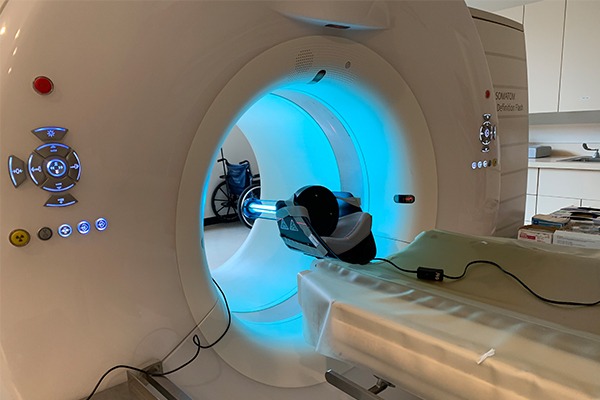In an effort to streamline medical imaging workflow, researchers at Johns Hopkins are testing the use of UV light to disinfect CT scanners within a matter of minutes—an especially important goal amid the COVID-19 pandemic.
The CT scanner is a vital tool for imaging lung disease, but manually cleaning it takes around 30 minutes, limiting its use during periods of high patient volumes. Jeffrey Siewerdsen, a professor in the Department of Biomedical Engineering at Johns Hopkins, and Mahadevappa Mahesh, professor of radiology and radiological science in the Johns Hopkins School of Medicine, have partnered to speed up and improve this crucial decontamination process.
In a paper published in the Journal of Applied Clinical Medical Physics, Siewerdsen and Mahesh investigate the feasibility and practicality of using ultraviolet (UV-C) irradiation to decontaminate the scanner’s inner bore—a cramped space that is exposed to exhaled particles from patients and is difficult to reach by manually wiping it down.
The researchers found that a UV-C lamp attached to the scanner bed is able to wipe out 99.9999% of SARS-CoV-2 virus particles in about five minutes. The UV-C rays used in this study are different from UV-A rays and must be used with caution to avoid damage to one’s eyes or skin.
“The role of CT imaging for detection of COVID-19 became a very important question in the early stages of the outbreak, and a major challenge was the manual wipe-down procedure between patients,” said Mahesh. “Manual wipe-down presents a slow workflow with at least a half-hour between patients, and carries additional occupational exposure to staff.”
Siewerdsen and Mahesh concluded that use of UV-C irradiation could augment manual wipe-down procedures, improve safety for CT technologists and housekeeping staff, and could potentially reduce turnover time between scanning sessions.
“Early in the Hopkins COVID-19 response, colleagues from BME, Radiology, and Radiation Oncology recognized the potential of ultraviolet light decontamination, and a Surgineering team even looked at how UV-C could be used to decontaminate N95 masks,” said Siewerdsen. “The studies reported in this paper were conducted in collaboration between BME and Radiology medical physics, and we were excited to see that a simple UV-C lamp placed inside the CT scanner bore delivered greater than 6-log kill in just a few minutes.”
The researchers also note that there may be crevices in the CT scanner that are not reachable with the UV light. If this procedure proves useful, the process could be used in addition to the manual wipe-down of CT scanners, and would be applicable to many health care facilities around the globe.
Editor’s note: Exposure to UV-C light could harm health and should not be used without proper training and safety precautions.

